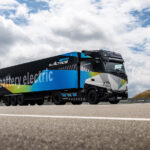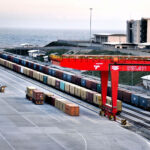World’s largest hydrogen haulier
World’s largest hydrogen haulier
In less than three years, Anglo American and Engie have delivered a prototype of the world’s largest hydrogen-powered mine haul truck. The truck is designed to operate in everyday mining conditions at Anglo’s Mogalakwena platinum mine in Limpopo.
The two megawatt hydrogen-battery hybrid truck, generating more power than its diesel predecessor and capable of carrying a 290 tonne payload, is part of Anglo American’s NuGen Zero Emission Haulage Solution (ZEHS). The ZEHS programme is one aspect of Anglo American’s innovation-led “FutureSmart Mining” approach to sustainable mining, which brings together technology and digitalisation to drive sustainability outcomes, including the company’s commitment to carbon neutrality across its operations by 2040.
Global energy and energy services company Engie is providing a fully integrated green hydrogen system – including production, compression, storage, and refuelling – in record time, with green hydrogen being produced at the mine site.
“At Engie, we realise the importance of green hydrogen in the decarbonisation of heavy-duty mobility, and we are dedicated to helping industry players accomplish their carbon neutrality goals,” says Sébastien Arbola, executive vice president in charge of thermal generation, hydrogen, and energy supply at Engie.
“We are delighted to partner with Anglo American to provide renewable hydrogen. Through this partnership, we aim to unlock the potential of green hydrogen in South Africa and pave the way for the decarbonisation of the mining industry,” he adds.
“NuGen is a tangible demonstration of our FutureSmart Mining programme changing the future of our industry,” enthuses Duncan Wanblad, chief executive of Anglo American. “With diesel emissions from our haul truck fleet accounting for 10 to 15% of our total Scope 1 emissions, this is an important step on our pathway to carbon neutral operations by 2040.”
Wanblad notes that the mining industry is playing a considerable role in helping the world decarbonise. “(This is done) both through our own emissions footprint, and the metals and minerals that we produce that are critical to low carbon energy and transport systems,” he explains. “Over the next several years, we envisage converting or replacing our current fleet of diesel-powered trucks with this zero-emission haulage system, fuelled with green hydrogen.”
Anglo American could remove up to 80% of its diesel emissions at its open pit mines by rolling out the hydrogen-powered mine haul truck technology across its global fleet. To help the global mining company to achieve this goal, it has entered into a merger with international creative engineering company First Mode to brand the NuGen ZEHS haul truck under the First Mode name.
“We started First Mode to solve meaningful and difficult problems,” says Chris Voorhees, president and CEO of the company. “Climate change and energy security are the paramount challenges of our time, and I am so proud this will be First Mode’s focus as we enter this next phase of growth. Now is the right time – and this is the right team – to build the barely possible for this extraordinary set of problems.”
The world’s largest hydrogen haulier did present some engineering challenges. “Even though much of the zero-emission technology used in the NuGen truck existed commercially, it did not exist as a cohesive commercial element suited to the scale and ruggedness of this kind of truck,” says Josh Sweere, a principal systems engineer at First Mode. “The team had to take these commercial systems and scale them to meet the power demand of an ultra-class haul truck. Stitching together commercial components that were never meant to coexist simultaneously on the same platform required a lot of ‘glue’ engineering to allow the system’s various fluids, communications connections, and power connections to peacefully coexist.”
“We are incredibly proud of what our team, working with expert partners, has achieved in under three years. This is truly a world-class innovation and bears testament to our technical vision and determination to deliver a cleaner and smarter future for mining,” adds Tony O’Neill, technical director of Anglo American.
“These game-changing innovations are exactly why we began our FutureSmart Mining journey in 2014, knowing how much of a difference we can make, including in the energy transition and across our societal footprint. Innovative, clean and independent power systems, such as our NuGen ZEHS project, offer a significant part of the emissions solution.”
South Africa’s Hydrogen Valley
In South Africa, the Department of Science and Innovation and the South African National Development Institute are looking into opportunities to create a “hydrogen valley”, in partnership with Anglo American, Engie, and Bambili Energy.
This proposed hydrogen valley will stretch approximately 835 km from the platinum group metals (PGMs)-rich bushveld geological area in Limpopo, along the industrial and commercial corridor to Johannesburg, and to the south coast at Durban. NuGen ZEHS is one of the first projects for South Africa’s Hydrogen Valley.
A feasibility study for the valley, published in October 2021, identifies three hubs: Johannesburg (extending to Rustenburg and Pretoria), Durban (encompassing the city itself and Richards Bay), and Limpopo (centred around Anglo American’s Mogalakwena PGMs mine). These hubs have a fundamental role to play in integrating hydrogen into South Africa’s economy, and in establishing South Africa and its abundant renewable energy resources as a strategically important centre for green hydrogen production. Nine key pilot projects have also been identified across these hubs and are recommended to be prioritised by developers. They span the transport, industrial, and construction sectors.
“Hydrogen has a significant and wide-ranging role to play in achieving a low carbon future – particularly as an energy carrier enabling the development of a renewables-based power generation system,” says Natascha Viljoen, CEO of Anglo American Platinum. “We are particularly excited about the potential of NuGen, amongst other opportunities, as we work to champion the development of South Africa’s Hydrogen Valley.”
Wanblad expands on this, saying, “The impact of our NuGen project goes far beyond our operations. We believe that the emerging hydrogen sector has the potential to dramatically improve the growth and development of many economies by creating new industrial value chains and economic generation opportunities. Growing the hydrogen economy will revolutionise not just Anglo American’s operations, but all mining and many other industries – and ultimately shape a better, cleaner world.”
Published by
Focus on Transport
focusmagsa




